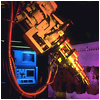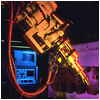Learn About the U.S. > Work and Workplaces in the U.S. > Industries > The American Dream and the Housing Industry

|

Industries
- Changes in Industry in the United States
- U.S. Auto Industry
- Changes in the U.S. Automobile Industry
- The Auto Industry in the Midwest
- Foreign Investment in Industry in the U.S.
- Workplace Safety Standards
- Work-related Injuries and Deaths
- The American Dream and the Housing Industry
- The American Dream and the Mobile Home
- The Rust Belt
|

A 17-ton pre-cast roof is put into position
on a prefab home in Virginia.
Photo from "Call It Home: The House That Private Enterprise Built," a videodisc by Keller Easterling and Rick Prelinger.
The American Dream and the Housing Industry
After WWII, in the 1950's, there was a boom in the U.S. housing market as new immigrants and returning soldiers sought to live "The American Dream". Part of this 'dream' included every family owning its own home, a car, and automated appliances that eased the workload of the homemaker. Due to technological advances in fabrication, the housing industry in the 1950's and 1960's was able to provide affordable homes to the masses. One reason was the invention of prefabricated homes, or prefabs. Most pieces of a prefab home are built at the factory, including major parts like the walls and roof. The prefab pieces are trucked to the building site and quickly assembled. This method proved cheaper for the housing industry and houses became more affordable. Prefabs feature complete indoor plumbing, bathroom, central heating, and electrical wiring.
|
|
|
| Download Podcast in
English
| Japanese
|
|
Document |
Audio-Video |
Chart |
Picture |
Map
|
|

